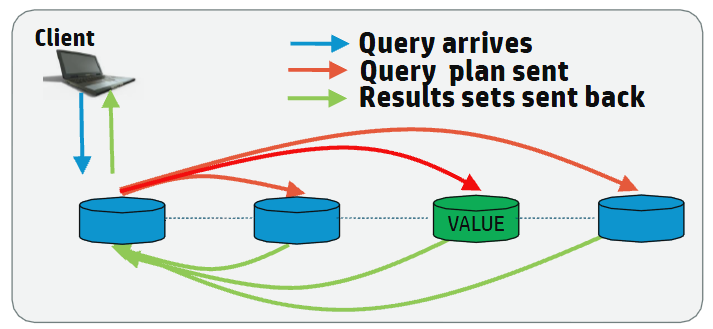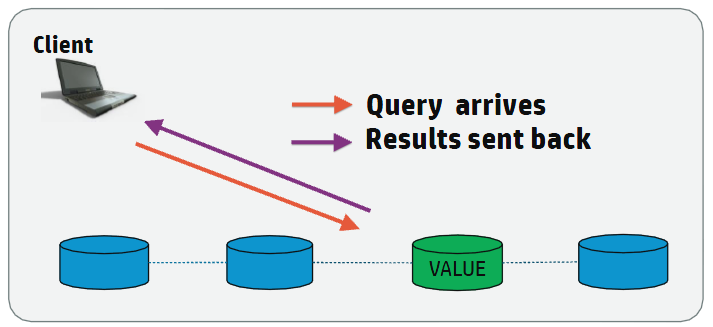Routing JDBC Queries Directly to a Single Node
The JDBC driver has the ability to route queries directly to a single node using a special connection called a Routable Connection. This feature is ideal for high-volume "short" requests that return a small number of results that all exist on a single node. The common scenario for using this feature is to do high-volume lookups on data that is identified with a unique key. Routable queries typically provide lower latency and use less system resources than distributed queries. However, the data being queried must be segmented in such a way that the JDBC client can determine on which node the data resides.
Vertica Typical Analytic Query
Typical analytic queries require dense computation on data across all nodes in the cluster and benefit from having all nodes involved in the planning and execution of the queries.

Vertica Routable Query API Query
For high-volume queries that return a single or a few rows of data, it is more efficient to execute the query on the single node that contains the data.

To effectively route a request to a single node, the client must determine the specific node on which the data resides. For the client to be able to determine the correct node, the table must be segmented by one or more columns. For example, if you segment a table on a Primary Key (PK) column, then the client can determine on which node the data resides based on the Primary Key and directly connect to that node to quickly fulfill the request.
The Routable Query API provides two classes for performing routable queries: VerticaRoutableExecutor and VGet. VerticaRoutableExecutor provides a more expressive SQL-based API while VGet provides a more structured API for programmatic access.
-
The VerticaRoutableExecutor class allows you to use traditional SQL with a reduced feature set to query data on a single node.
For joins, the table must be joined on a key column that exists in each table you are joining, and the tables must be segmented on that key. However, this is not true for unsegmented tables, which can always be joined (since all the data in an unsegmented table is available on all nodes).
-
The VGet class does not use traditional SQL syntax. Instead, it uses a data structure that you build by defining predicates and predicate expressions and outputs and output expressions. This class is ideal for doing Key/Value type lookups on single tables.
The data structure used for querying the table must provide a predicate for each segmented column defined in the projection for the table. You must provide, at a minimum, a predicate with a constant value for each segmented column. For example, an
idwith a value of 12234 if the table is segmented only on theidcolumn. You can also specify additional predicates for the other, non-segmented, columns in the table. Predicates act like a SQL WHERE clause and multiple predicates/predicate expressions apply together with a SQL AND modifier. Predicates must be defined with a constant value. Predicate expressions can be used to refine the query and can contain any arbitrary SQL expressions (such as less than, greater than, and so on) for any of the non-segmented columns in the table.
Java documentation for all classes and methods in the JDBC Driver is available in the Vertica JDBC Documentation.
The JDBC Routable Query API is read-only and requires JDK 1.6 or greater.